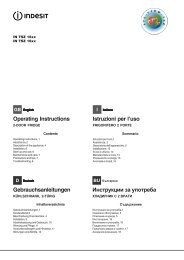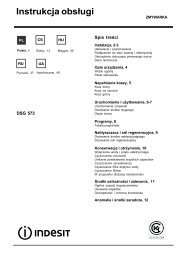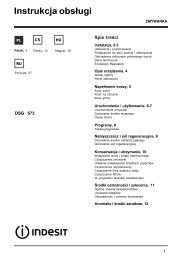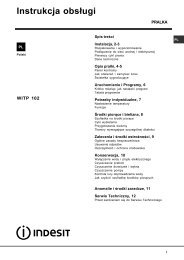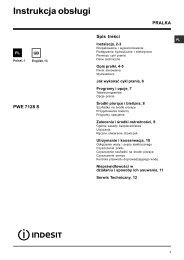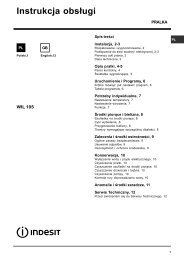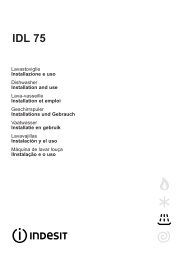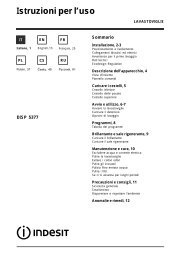Instructions for use - Indesit
Instructions for use - Indesit
Instructions for use - Indesit
Create successful ePaper yourself
Turn your PDF publications into a flip-book with our unique Google optimized e-Paper software.
Precautions and advice<br />
! The Washer-dryer was designed and built in<br />
compliance with the applicable international safety<br />
regulations. The following in<strong>for</strong>mation is provided <strong>for</strong><br />
your safety and should consequently be read carefully.<br />
General safety<br />
• This appliance has been designed <strong>for</strong> nonprofessional,<br />
ho<strong>use</strong>hold <strong>use</strong> and its functions must<br />
not be changed.<br />
• This washing machine should only be <strong>use</strong>d by<br />
adults and in accordance with the instructions<br />
provided in this manual.<br />
• Never touch the washing machine when barefoot<br />
or with wet or damp hands or feet.<br />
• Do not pull on the power supply cable to unplug<br />
the appliance from the electricity socket. Pull the<br />
plug out yourself.<br />
• Do not open the detergent dispenser while the<br />
appliance is in operation.<br />
• Do not touch the drain water as it could reach<br />
very high temperatures.<br />
• Never <strong>for</strong>ce the washing machine door: this could<br />
damage the safety lock mechanism designed to<br />
prevent any accidental openings.<br />
• In the event of a malfunction, do not under any<br />
circumstances touch internal parts in order to<br />
attempt repairs.<br />
• Always keep children well away from the<br />
appliance while in operation.<br />
• The appliance door tends to get quite hot during<br />
the wash cycle.<br />
• Should it have to be moved, proceed with the<br />
help of two or three people and handle it with the<br />
utmost care. Never try to do this alone, beca<strong>use</strong><br />
the appliance is very heavy.<br />
• Be<strong>for</strong>e loading your laundry into the washing<br />
machine, make sure the drum is empty.<br />
• During the drying phase, the door tends to get<br />
quite hot.<br />
• Do not <strong>use</strong> the appliance to dry clothes that have<br />
been washed with flammable solvents (e.g.<br />
trichlorethylene).<br />
• Do not <strong>use</strong> the appliance to dry foam rubber or<br />
similar elastomers.<br />
• Make sure that the water tap is turned on during<br />
the drying cycles.<br />
• This washer-dryer can only be <strong>use</strong>d to dry clothes<br />
which have been pre-washed in water.<br />
Disposal<br />
• Disposing of the packaging material:<br />
observe local regulations, so the packaging can<br />
be re-<strong>use</strong>d.<br />
• The European Directive 2002/96/EC on Waste<br />
Electrical and Electronic Equipment, requires that<br />
old ho<strong>use</strong>hold electrical appliances must not be<br />
disposed of in the normal unsorted municipal waste<br />
stream. Old appliances must be collected<br />
separately in order to optimise the recovery and<br />
recycling of the materials they contain and reduce<br />
the impact on human health and the environment.<br />
The crossed out "wheeled bin" symbol on the<br />
product reminds you of your obligation, that when<br />
you dispose of the appliance it must be separately<br />
collected.<br />
Consumers should contact their local authority or<br />
retailer <strong>for</strong> in<strong>for</strong>mation concerning the correct<br />
disposal of their old appliance.<br />
Saving energy and respecting the<br />
environment<br />
Environmentally-friendly technology<br />
If you only see a little water through your appliance<br />
door, this is beca<strong>use</strong> thanks to the latest <strong>Indesit</strong><br />
technology, your washing machine only needs less<br />
than half the amount of water to get the best results:<br />
an objective reached to respect the environment.<br />
Saving on detergent, water, energy and time<br />
• To avoid wasting resources, the Washer-dryer<br />
should be <strong>use</strong>d with a full load. A full load instead<br />
of two half loads allows you to save up to 50% on<br />
energy.<br />
• The pre-wash cycle is only necessary on<br />
extremely soiled garments. Avoiding it will save on<br />
detergent, time, water and between 5 and 15%<br />
energy.<br />
• Treating stains with a stain remover or leaving<br />
them to soak be<strong>for</strong>e washing will cut down the<br />
need to wash them at high temperatures. A<br />
programme at 60°C instead of 90°C or one at<br />
40°C instead of 60°C will save up to 50% on<br />
energy.<br />
• Use the correct quantity of detergent depending<br />
on the water hardness, how soiled the garments<br />
are and the amount of laundry you have, to avoid<br />
wastage and to protect the environment: despite<br />
being biodegradable, detergents do contain<br />
ingredients that alter the natural balance of the<br />
environment. In addition, avoid using fabric<br />
softener as much as possible.<br />
• If you <strong>use</strong> your washing machine from late in the<br />
afternoon until the early hours of the morning, you<br />
will help reduce the electricity board's peak load.<br />
The Delay Timer option (see page 7) helps to<br />
organise your wash cycles accordingly.<br />
• If your laundry has to be dried in a tumble dryer,<br />
select a high spin speed. Having the least water<br />
possible in your laundry will save you time and<br />
energy in the drying process.<br />
GB<br />
9



